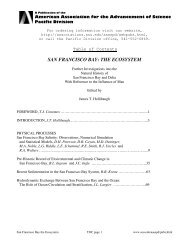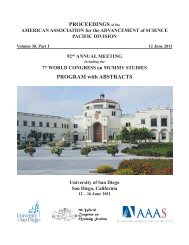Vol 31, Part I - forums.sou.edu ⢠Index page - Southern Oregon ...
Vol 31, Part I - forums.sou.edu ⢠Index page - Southern Oregon ...
Vol 31, Part I - forums.sou.edu ⢠Index page - Southern Oregon ...
Create successful ePaper yourself
Turn your PDF publications into a flip-book with our unique Google optimized e-Paper software.
ABSTRACTS – Contributed Oral Papers<br />
continent was designated a protected natural area. Parks—<br />
and the land ethics and conservation agendas they represent—infuse<br />
the frozen Andean borders of Argentina and<br />
Chile making up the region of Patagonia and they permeate<br />
the boundary between Peru and Brazil that share, along with<br />
several other countries, the region of Amazonia. The parks<br />
form contiguous transnational swaths of nature but they exist<br />
in a historical vacuum; little is known about their comparative<br />
declaration, evolution, and meaning despite a collective<br />
consciousness at home and abroad about the extensive wilderness<br />
areas they protect. This paper provides an overview<br />
of the similarities and contrasts between nature protection in<br />
tropical and temperate South America with attention to the<br />
global trends in national parks. It argues that the role of individual<br />
scientists, state agencies, international organizations,<br />
and local stakeholders shaped conservation agendas and<br />
actions in distinct ways that serve to temper global debates<br />
about conservation refugees and exclusion. The paper gives<br />
special attention to the role of scientific research in defining—and<br />
being defined by—transnational natural areas, the<br />
significance of these areas in the constitution of national<br />
identities through frontier settlement, and the ways global<br />
exchanges shaped the categorization of landscapes and their<br />
growth as inter-connecting webs of land use.<br />
147 Millennial Biology: The National Science Foundation<br />
and the Life Sciences, 1975-2005, DONALD J McGRAW<br />
(“Dr. Donald J. McGraw, Independent Scholar/Contractor,”<br />
P.O.Box 515, Ephraim, UT, 84627; donaldmcgraw@mac.<br />
com).<br />
At the past several meetings of the AAAS/Pacific Division,<br />
Dr. McGraw has presented several talks in a series of<br />
interim reports on the status of his book being written under<br />
contract to the National Science Foundation. In his earlier<br />
reports, the author described the contract and the research<br />
period efforts and discussions of completed draft chapters.<br />
The present report is the final in the series. It will describe<br />
work accomplished on all sections of the ten-chapter book of<br />
some 650 <strong>page</strong>s and its present status.<br />
148 A Novel Explanation of Creationism’s Frustrating Persistence,<br />
LAWRENCE H WOOD (Physicist, Retired, 8433<br />
Camano Loop NE, Lacey, WA 98516; marylar@comcast.<br />
net).<br />
Despite significant Scientific advances over the past<br />
2500 years, polls continually reveal that a majority of Americans<br />
prefer Creationism, which avers that “There is no reason<br />
not to believe that God [an undetectable, supernatural<br />
“magician”] created our universe, earth, plants, animals, and<br />
people just as described in the book of Genesis (www.bestbiblescience.org/mainpts.htm).”<br />
The tenaciousness of this<br />
belief can be shown to result from a variation on the bold<br />
Jesuit claim “give me a child until he is seven and I will give<br />
you the man.”<br />
Thus “Creationism indoctrination” given young children<br />
explains Creationism’s persistence; viz., the Creationism<br />
concept is relatively simple, thus, a young child can easily<br />
understand it, but hasn’t enough knowledge to realize that<br />
it is preposterous. The Creationism indoctrination continues<br />
until the child reaches High School and encounters Evolution<br />
for the first time, but by then has been “brain washed”<br />
against it. This paper presents a clear explanation of Creationism’s<br />
origin including its bizarre belief in a supernatural<br />
magician, something I haven’t seen articulated but which<br />
aids in understanding Creationism’s persistence. In addition,<br />
the futility of anti-Creationism efforts presenting “mountains<br />
of evidence” supporting science, which are unfortunately<br />
easily “cherry picked” by creationists are analyzed.<br />
Finally a clear explanation of how the Process of Evolution<br />
works which might be understandable by a young child is<br />
presented. This paper should be of interest to any Scientist<br />
interested in understanding Creationism’s origin, why it is so<br />
persistent and possible techniques for changing Creationists<br />
beliefs.<br />
149 From 1953 Genetics: Molecular Biology to the Wider<br />
Pictures of Both Science and its Religious Basis, Danielle<br />
Mihram 1 * and G ARTHUR Mihram 2 ( 1 USC<br />
Libraries and Department of French and Italian, University<br />
of <strong>Southern</strong> California, 650 W 35 th Street, Los Angeles, CA<br />
90089-2571; 2 P.O. Box 1188, Princeton, NJ 08542-1188;<br />
dmihram@usc.<strong>edu</strong>).<br />
The history of modern biology has been enhanced since<br />
the 1953 discovery of the double helix [James Watson, Francis<br />
Crick (plus Maurice Wilkins, Rosalind Franklin)], the<br />
physical context by which the transmission of characteristics<br />
(between successive generations) can qualify quite explicitly<br />
as the explanation for biological evolution.<br />
We relate three post-1953 historical developments. First,<br />
the quickly ensuing (new) discipline of molecular biology<br />
quite naturally appeared; yet, this itself has only served as a<br />
further confirmation of Darwin’s On the Origin of Species<br />
by Means of Natural Selection. One can now note the<br />
ensuing fascination with ‘chromosomal abnormalities’ present<br />
in cancers, leading to the promise of medical cures.<br />
Second, an examination of the founding basis of the very<br />
human activity (extracorporeal model-building) has led not<br />
only to neurologist JZ Young’s recognition [Model of the<br />
Brain] of this as the biological characteristic uniquely defining<br />
Mankind among the species but also to our consequent<br />
conclusion [Teorema 28(2): 35-44 (2009)] that Science is<br />
conducted, as properly implemented natural philosophy, in<br />
a six-stage model-building process (Scientific Method). This<br />
very process, first conducted without cognition by the ‘gene<br />
pools’ of each plant and animal species, has been followed<br />
by the ‘higher’ species of animals, those having the neural<br />
capability of memory-and-recall, to construct mental models<br />
enhancing survival.<br />
91








